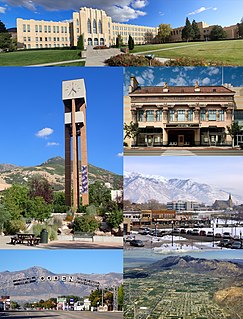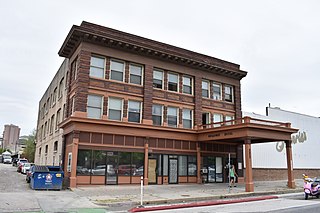Scouting in Utah has a long history, from the 1910s to the present day, serving thousands of youth in programs that suit the environment in which they live.

Murray is a city situated on the Wasatch Front in the core of Salt Lake Valley in the U.S. state of Utah. Named for territorial governor Eli Murray, it is the state's fourteenth largest city. According to the 2010 census, Murray has approximately 46,746 residents. Murray shares borders with Taylorsville, Holladay, South Salt Lake and West Jordan, Utah. Once teeming with heavy industry, Murray's industrial sector now has little trace and has been replaced by major mercantile sectors. Known for its central location in Salt Lake County, Murray has been called the Hub of Salt Lake County. Unlike most of its neighboring communities, Murray operates its own police, fire, power, water, library, and parks and recreation departments and has its own school district. While maintaining many of its own services, Murray has one of the lowest city tax rates in the state.

Ogden is a city in and the county seat of Weber County, Utah, United States, approximately 10 miles (16 km) east of the Great Salt Lake and 40 miles (64 km) north of Salt Lake City. The population was 87,773 in 2019, according to the US Census Bureau, making it Utah's seventh largest city. The city served as a major railway hub through much of its history, and still handles a great deal of freight rail traffic which makes it a convenient location for manufacturing and commerce. Ogden is also known for its many historic buildings, proximity to the Wasatch Mountains, and as the location of Weber State University.

The Utah State Capitol is the house of government for the U.S. state of Utah. The building houses the chambers and offices of the Utah State Legislature, the offices of the Governor, Lieutenant Governor, Attorney General, the State Auditor and their staffs. The capitol is the main building of the Utah State Capitol Complex, which is located on Capitol Hill, overlooking downtown Salt Lake City.

Ogden High School is an Art Deco secondary school located in Ogden, Utah, educating students in grades 10–12. Operated by the Ogden City School District, Ogden High enrolls approximately 1,250 students each year. The graduation rate has increased dramatically over the past three years. The school houses an International Baccalaureate Programme, a Project Lead the Way program and a thriving Life Sciences/Pre-Med program. OHS also offers a dozen AP classes and the AVID program. The most recent state championship is for girls soccer 2019. The Ogden High mascot is the Tiger. In 2012, Ogden High School began offering International Baccalaureate courses and in 2014 graduated the first IB Diploma Programme class.

The Cottonwood Paper Mill is an abandoned stone structure located at the mouth of Big Cottonwood Canyon in Cottonwood Heights, Utah. It was listed on the National Register of Historic Places in 1971.

The Murray Downtown Residential Historic District is the best representative area of the residential settlement and development of the city of Murray, Utah, United States. It was listed on the National Register of Historic Places in 2005. It is locally significant as a physical reflection of its residential architecture and the historic development of the city from its agricultural beginnings through its industrial era and current status as a small suburban city. The buildings within the district represent the wide range of architectural styles and plans popular in the city and the state of Utah between 1870 and 1954 and retain a high degree of integrity.

Clayton Tryon Teetzel was an American athlete and athletic coach. He played American football and competed in track for the University of Michigan from 1897 to 1899 and later coached football, basketball and track at Michigan State Normal College, Benton Harbor High School, Brigham Young University, and Utah State University.
Richard Charles Watkins, an immigrant from Bristol, England, was an American architect throughout the intermountain west in the late 19th and early 20th centuries. In his early career he interned with Richard K.A. Kletting in Salt Lake City. In 1890 he came to Provo, Utah as a construction supervisor, and opened his own firm in 1892. When he left nearly 20 years later he had become the most prominent architect south of Salt Lake City, Utah. His works include designing over 240 schools in the intermountain west of the United States including. He served as the architect for Utah State Schools between 1912 and 1920. He also designed businesses, courthouses, eight Carnegie libraries, churches and homes. A number of his buildings survive and are listed on the U.S. National Register of Historic Places.

Elias Lacy Thomas Harrison was an architect and writer in Salt Lake City, Utah, who became important in the history of Utah and the Latter Day Saint movement.
Hyrum Conrad Pope was a German-born architect with important architectural works throughout the western United States and Canada. Pope was born in Fürth, Bavaria and immigrated to the United States as a teenager. He went to school at the Art Institute of Chicago where he was influenced in the Prairie School architectural style. In 1910, he opened an architectural firm with Harold W. Burton in Salt Lake City, Utah. Pope designed a variety of places of worship for many faiths, civic buildings and homes, some of which are listed on the National Register of Historic Places.

Kearns-Saint Ann School is a Catholic school located in South Salt Lake, Utah, built in 1899. It is home to students in grades Preschool through 8th grade. Kearns-Saint Ann School began as an orphanage in the late 1800s, and continues its legacy of the caring for and educating of children which was begun in 1891 by the Sisters of the Holy Cross.

Jimmy Reagan was an American boxer who claimed the World Bantamweight Championship in a twelve-round bout on January 29, 1909 against Jimmy Walsh at Dreamland Rink in San Francisco, California. He lost the title only a month later in an historic twenty round bout on February 22, 1909 to Monte Attell at the Mission Street Arena in San Francisco. Reagan's primary manager was Jack Davis. During his career he fought Battling Nelson, Peanuts Sinclair, future lightweight champion Willie Ritchie, World Feather and Lightweight contender "Mexican Joe" Rivers and reigning lightweight champion Benny Leonard.

The Daft Block, also known as the Daynes Jewelry Building, in Salt Lake City, Utah, is a 4-story Richardsonian Romanesque commercial building designed by Elias L. T. Harrison and H.W. Nichols and constructed 1887–1889. The brick building is trimmed with sandstone sills and lintels, and it features a prominent, two-story bay window. Above the bay window is a decorative sandstone pediment. The building was added to the National Register of Historic Places in 1976.

The Kearns Building in Salt Lake City, Utah, is a 10-story office building designed by Los Angeles architects John Parkinson and George Bergstrom and constructed 1909–1911. Parkinson & Bergstrom borrowed the style of architect Louis Sullivan, and the Kearns Building has been described as Sullivanesque, with a steel reinforced concrete frame and a white terracotta tile facade emphasizing vertical piers below a prominent cornice. The building was added to the National Register of Historic Places in 1982.

The J.G. McDonald Chocolate Company Building in Salt Lake City, Utah, United States, is a 4-story commercial structure designed by John A. Headlund and completed in 1901. The original 3-story brick and stone building was expanded to four stories soon after construction, and it continued to expand as the company grew. The building was added to the National Register of Historic Places in 1978, and it is now included in the Warehouse District.

The Broadway Hotel is a historic hotel in Salt Lake City, Utah, United States.
Francis Charles Woods was a Scottish-born American architect and organ-builder who designed many buildings in Utah and Idaho. Some of his works are listed on the National Register of Historic Places (NRHP), including the Hotel Brigham and the Summit County Courthouse.
The Ogden Gunners was the final moniker minor league baseball teams based in Ogden, Utah between 1900 and 1928. The Ogden Gunners played the 1926–1928 seasons in the Class C level Utah–Idaho League. The Ogden Gunners were preceded by Ogden teams in the Inter-Mountain League (1901), Utah State League (1902), Pacific National League (1905), Union Association (1912–1914) and Northern Utah League (1921).
















